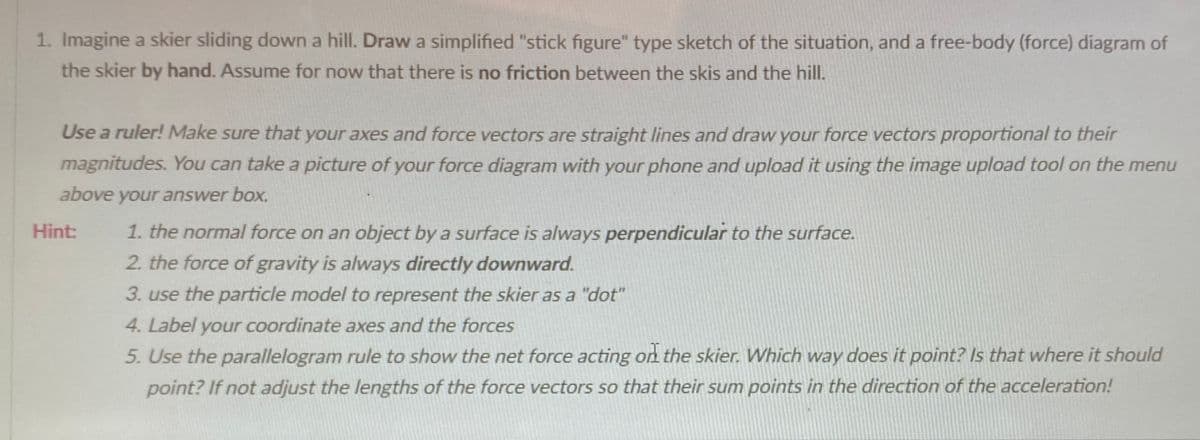Imagine a skier sliding down a hill. Draw a simplified "stick figure" type sketch of the situation, and a free-body (force) diagram of the skier by hand. Assume for now that there is no friction between the skis and the hill. Use a ruler! Make sure that your axes and force vectors are straight lines and draw your force vectors proportional to their magnitudes. You can take a picture of your force diagram with your phone and upload it using the image upload tool on the menu above your answer box. nt: 1. the normal force on an object by a surface is always perpendicular to the surface. 2. the force of gravity is always directly downward. 3. use the particle model to represent the skier as a "dot" 4. Label your coordinate axes and the forces 5. Use the parallelogram rule to show the net force acting on the skier. Which way does it point? Is that where it should point? If not adjust the lengths of the force vectors so that their sum points in the direction of the acceleration!
Imagine a skier sliding down a hill. Draw a simplified "stick figure" type sketch of the situation, and a free-body (force) diagram of the skier by hand. Assume for now that there is no friction between the skis and the hill. Use a ruler! Make sure that your axes and force vectors are straight lines and draw your force vectors proportional to their magnitudes. You can take a picture of your force diagram with your phone and upload it using the image upload tool on the menu above your answer box. nt: 1. the normal force on an object by a surface is always perpendicular to the surface. 2. the force of gravity is always directly downward. 3. use the particle model to represent the skier as a "dot" 4. Label your coordinate axes and the forces 5. Use the parallelogram rule to show the net force acting on the skier. Which way does it point? Is that where it should point? If not adjust the lengths of the force vectors so that their sum points in the direction of the acceleration!
Related questions
Question

Transcribed Image Text:1. Imagine a skier sliding down a hill. Draw a simplified "stick figure" type sketch of the situation, and a free-body (force) diagram of
the skier by hand. Assume for now that there is no friction between the skis and the hill.
Use a ruler! Make sure that your axes and force vectors are straight lines and draw your force vectors proportional to their
magnitudes. You can take a picture of your force diagram with your phone and upload it using the image upload tool on the menu
above your answer box.
1. the normal force on an object by a surface is always perpendicular to the surface.
2. the force of gravity is always directly downward.
Hint:
3. use the particle model to represent the skier as a "dot"
4. Label your coordinate axes and the forces
5. Use the parallelogram rule to show the net force acting on the skier. Which way does it point? Is that where it should
point? If not adjust the lengths of the force vectors so that their sum points in the direction of the acceleration!
Expert Solution
This question has been solved!
Explore an expertly crafted, step-by-step solution for a thorough understanding of key concepts.
This is a popular solution!
Trending now
This is a popular solution!
Step by step
Solved in 3 steps with 3 images
